Which Lentils Have the Most Protein : A Quick Guide
Which lentils have the most protein? Lentils are a versatile and nutritious food option that offers numerous health benefits. They are packed with essential nutrients, such as vitamins, minerals, and dietary fibre. One key aspect that makes lentils an attractive choice, especially for vegetarians and vegans, is their protein content. If you’re looking for ways to increase your protein intake, understanding which lentils have the most protein can be extremely helpful.

Do Lentils Have Protein?
There are various types of lentils available in the market, each with its unique flavours and textures. While it’s true that all lentils are good sources of protein, some varieties boast a higher protein content than others.
For example, both Puy lentils and French green lentils contain 36 grams of protein per cup. Making an informed decision about which types of lentils to incorporate into your diet can help you maximise the protein benefits from these nutritious legumes.
In this article, you’ll discover the protein content of various lentil types and learn how to make the most of their nutritional value. You will also find useful tips and advice on how to incorporate these protein-rich lentils into your regular meals, ensuring that your diet is balanced and wholesome.
Protein In Lentils
Lentils are a fantastic source of plant-based protein, making them an essential staple in vegetarian and vegan diets. As part of the legume family, they provide a considerable amount of protein without the need for meat. Not only are they versatile ingredient in many cuisines, but they’re also packed with essential amino acids that your body requires for optimum health.
One type of lentil that stands out for its high protein content is the Puy lentil, which boasts an impressive 36 grams of protein per cup. These small, green-blue lentils are a popular choice among health-conscious individuals looking to increase their protein intake from plant sources. But Puy lentils aren’t the only protein-rich variety—other common lentil types like green, brown, and red lentils also contribute a decent amount of protein to your meals.
Besides their protein content, lentils offer numerous health benefits. They are low in sodium and saturated fat, but high in potassium, fibre, and folate. Folate, in particular, is crucial for pregnant women as it helps prevent neural tube defects in newborns and reduces the risk of gestational diabetes. The high fibre content in lentils also promotes digestive health and helps to keep you feeling full for longer periods.
Incorporating lentils into your diet is simple and delicious. You can add them to soups, salads, and stews, or even use them as a base for veggie burgers. When cooking lentils, be sure to rinse them well and soak them beforehand to reduce their cooking time and increase their digestibility. The variety of lentils available means that you can experiment with different flavours and textures to suit your tastes.
So, next time you’re searching for a satisfying, plant-based protein option, don’t hesitate to reach for lentils. They’re not only a versatile and delectable ingredient but also a powerhouse of essential nutrients that can boost your health and support your fitness goals.

Comparison of Different Lentil Types and Their Protein Content
In this section, we will explore the protein content of various types of lentils. We will discuss all the main types: Green Lentils, Brown Lentils, Puy Lentils, Black Lentils, and Red & Yellow Lentils.
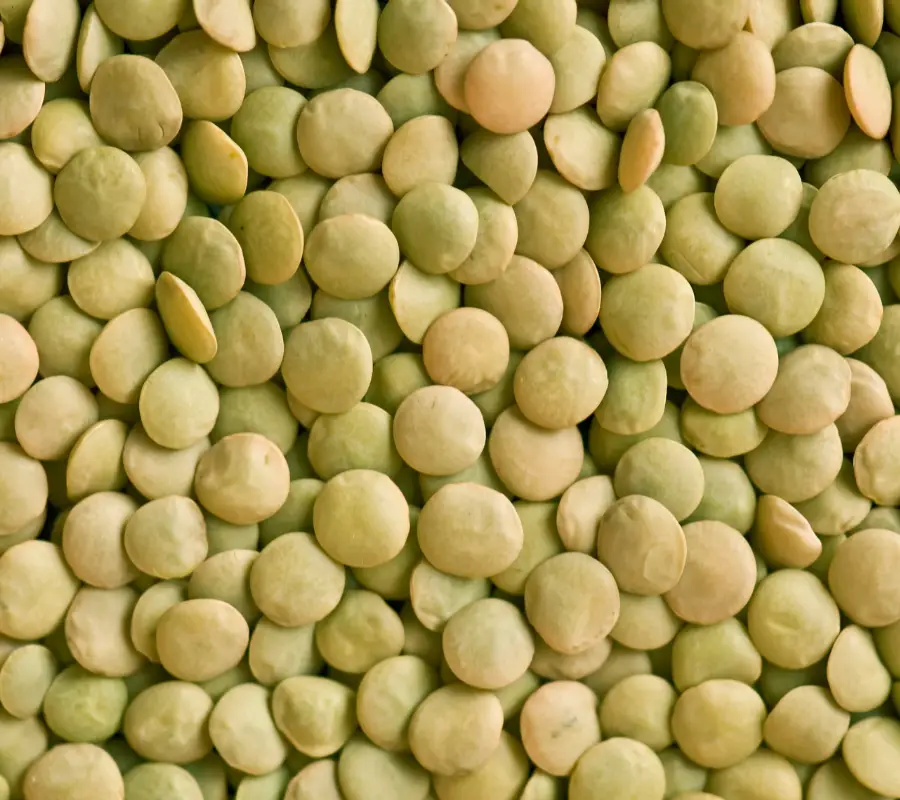
Green Lentils
Green lentils are a popular choice in various dishes for their earthy flavour and ability to maintain their shape after cooking. They are a reliable source of protein, providing a notable amount of protein per cup. Green lentils can be an excellent foundation for salads and stews.
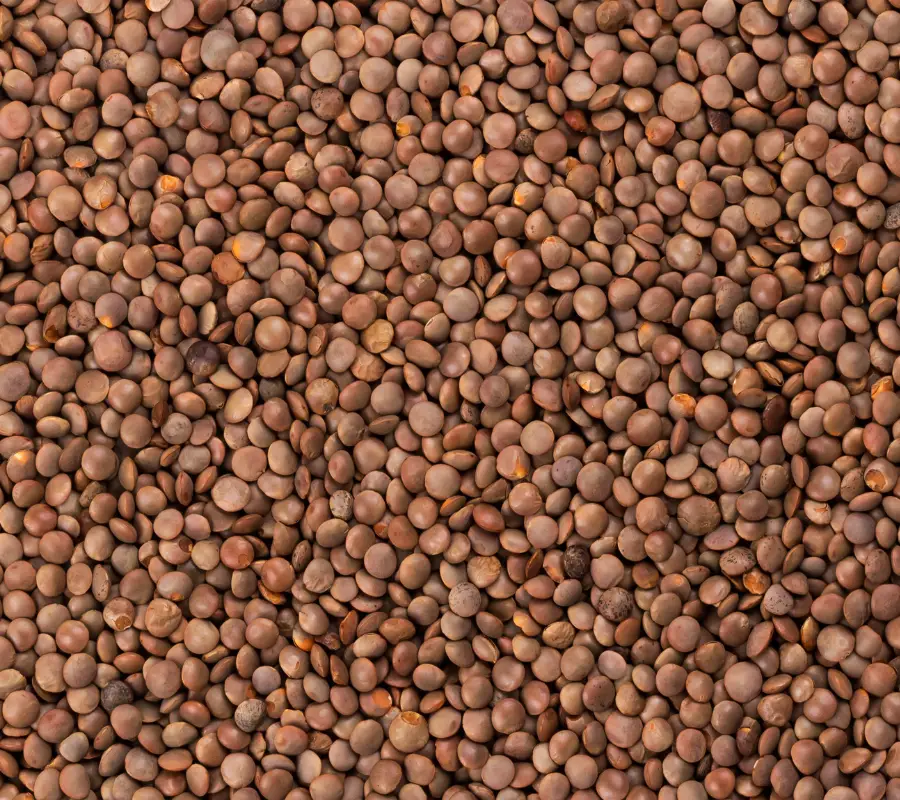
Brown Lentils
Brown lentils are widely used and versatile in the kitchen. They have a relatively mild and earthy flavour, which makes them suitable for use in various cuisines. Brown lentils have a comparable protein content to green lentils, making them an equally valuable addition to your pantry.
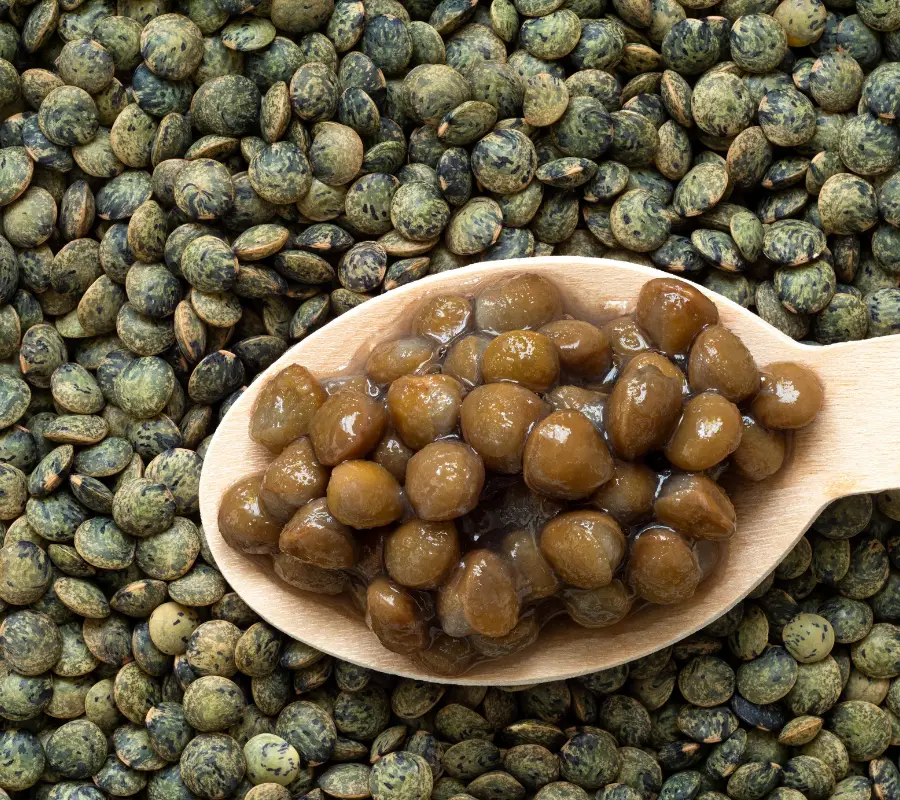
Puy Lentils
Puy lentils, also known as French green lentils, stand out for having the highest protein content among lentil varieties, with 36 grams of protein per cup. Moreover, Puy lentils have more protein per calorie than their French counterpart due to their lower calorie count. In addition to their protein content, they are known for their unique, peppery flavour.
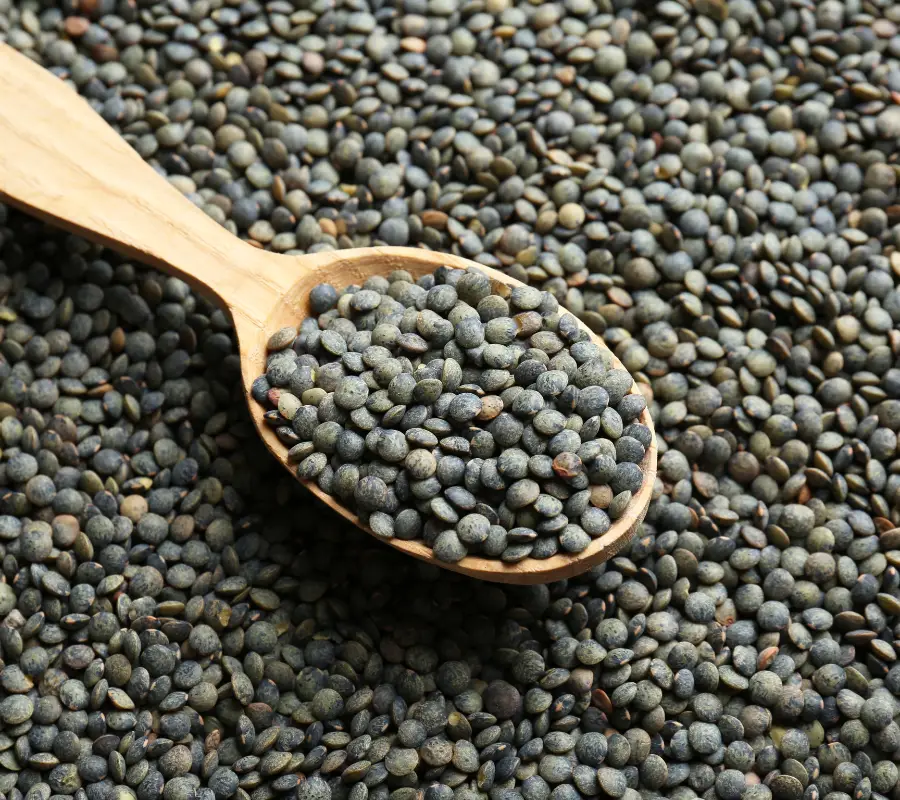
Black Lentils
Black lentils, also referred to as Beluga lentils are small, black, and resemble caviar. Although their protein content is not as high as Puy lentils, they still provide a good source of plant-based protein. Black lentils are especially suitable for use in warm salads or as a base for other dishes.
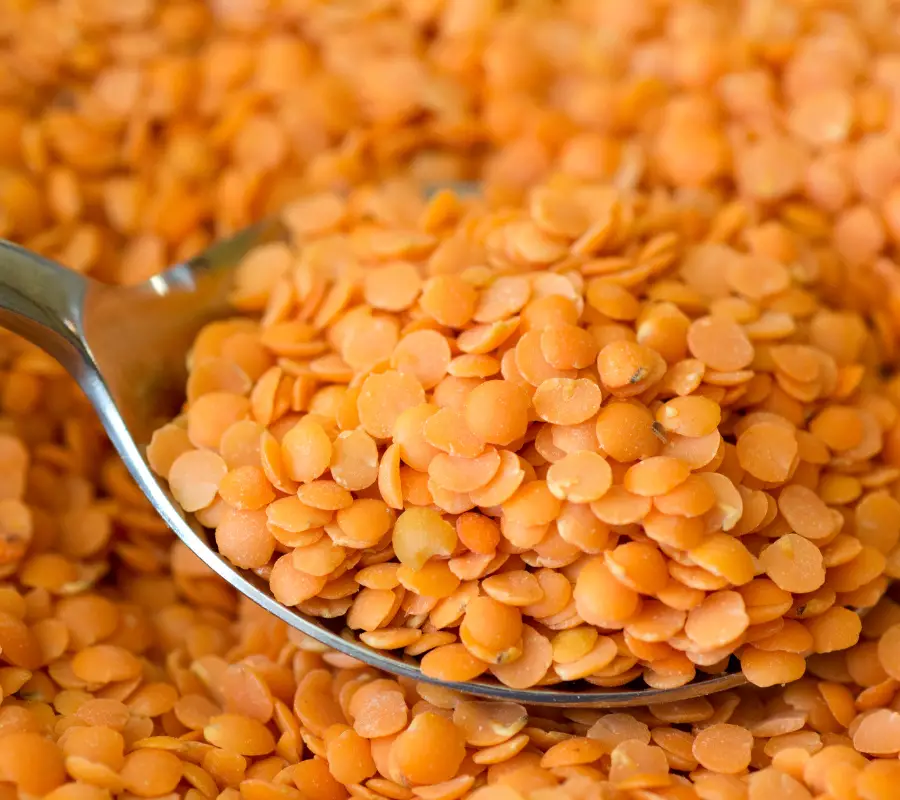
Red and Yellow Lentils
Red and yellow lentils are both split lentils, which means they cook faster than their whole counterparts. While they are not as protein-dense as Puy or green lentils, they still offer valuable protein content. These lentils are often used to create creamy dishes such as Indian dals and soups.
Highest Protein Lentils Table
Here’s a table summarising the protein content of each lentil variety:
| Lentil Type | Protein per Cup |
|---|---|
| Green Lentils | 18 grams |
| Brown Lentils | 18 grams |
| Puy Lentils | 36 grams – HIGHEST PROTEIN CONTENT |
| Black Lentils | 24 grams |
| Red/Yellow Lentils | 15 grams |
As you can see, Puy lentils have the highest amount of protein among the lentil varieties. However, all lentil types are valuable sources of plant-based protein and can be effortlessly incorporated into various dishes, providing you with essential nutrients.
Other Health Benefits of Lentils
Apart from being a rich source of protein, lentils offer various other health benefits that can contribute to a balanced and nutritious diet.
Lentils are an excellent source of fibre, which aids in digestion and helps maintain a healthy gut. A regular intake of fibre can also help in managing your blood sugar levels, thus supporting diabetes management. Lentils are relatively low in calories and contain a minimal amount of fat, making them an ideal choice for weight management and combating obesity.
These nutritious legumes are a great source of carbohydrates which provide energy for your daily activities. Moreover, lentils are packed with essential vitamins and minerals such as iron, folate, magnesium, and zinc, which contribute to overall health and well-being.
Iron is crucial for producing red blood cells and preventing anaemia, while folate is vital for cell growth and DNA synthesis. Magnesium supports bone health and muscle function, whereas zinc is necessary for a healthy immune system. Lentils are naturally cholesterol-free, making them heart-healthy and beneficial for maintaining good blood pressure levels.
Including lentils in your diet can have a positive impact on various aspects of your health. They are known to support heart health by reducing the risk of heart diseases, thanks to their high fibre content and antioxidant properties. Lentils are also beneficial for those with diabetes, as their low glycemic index helps in controlling blood sugar levels.
Furthermore, the fibre and essential nutrients found in lentils make them a potential ally in preventing cancer. Some studies suggest that regular consumption of lentils may reduce the risk of certain types of cancer, although more research is needed to confirm these findings.
Including Lentils in Your Diet
Lentils are an excellent source of protein, with Puy Lentils containing the highest amount – 36 grams of protein per cup. As part of the legume family, these versatile, nutrient-packed beans offer various benefits to your daily diet.
To get started, familiarise yourself with the different types of lentils available. For example, common varieties include green, brown, and red lentils. Each type varies in flavour, texture, and cooking time. Green lentils typically hold their shape well, providing a firmer texture, while red and brown lentils become soft and mushy when cooked. Experiment with these varieties to find your preferred taste and texture.
One popular way to incorporate lentils into your meals is by preparing a traditional Indian dish called dal. This comforting stew often combines lentils with fragrant spices like cumin, turmeric, and ginger. You can also use lentils as a substitute for meat in dishes like chilli and spaghetti Bolognese due to their high protein content and satisfying texture.
When cooking lentils, keep in mind that they should be thoroughly rinsed before use to remove any dirt or debris. Most lentils, except the split variety, need to be soaked for a few hours or overnight.
This not only reduces the cooking time but also helps to release the essential nutrients found in the seeds. Boiling or simmering lentils is the most common method of cooking, and the addition of aromatic spices can amplify their naturally mild flavour.
In addition to providing a protein boost, lentils are also a great source of fibre, iron, and other essential nutrients. Combining them with whole grains, such as rice or quinoa, can further enhance their nutritional value, as you’ll be consuming a complete protein. This means you will obtain all nine essential amino acids required for optimal body functioning and overall health.
So go ahead and include lentils in your diet, whether trying out a new recipe or incorporating them into your existing meals. Your body will thank you for the added nutrition and delightful flavours.
Frequently Asked Questions
What type of lentils contains the highest protein content?
Puy lentils contain the highest protein content, boasting 36 grams of protein per cup. These lentils are an excellent choice if you’re looking to increase your protein intake, particularly on a plant-based diet.
Do lentils have more protein than chicken?
Chicken is known for its high protein content, but how does it compare to lentils? Cooked lentils contain 9.02 grams of protein per 100 grams, whereas cooked chicken has around 31 grams of protein per 100 grams. Therefore, chicken contains more protein than lentils. However, lentils are still a nutritious option for those adhering to a plant-based diet or looking to diversify their protein sources.
How much protein is in 100g of various lentil types?
The exact protein content in 100 grams of lentils varies by type. Generally, cooked lentils contain 9.02 grams of protein per 100 grams. Puy lentils, with the highest protein content, have 36 grams per cup. To determine the protein content of other lentil types, like red, green, or brown, it’s essential to check for specific nutritional information.
Are certain lentils better for weight loss due to protein content?
Higher protein content can help manage one’s appetite and support weight loss, as it makes you feel fuller than other nutrients.
Although Puy lentils have the highest protein content among lentil types, all lentils provide a good quantity of protein and can contribute to a healthy, well-rounded weight loss plan. Incorporating various lentil types into your diet can promote satiety and provide additional vitamins and minerals essential for overall health.